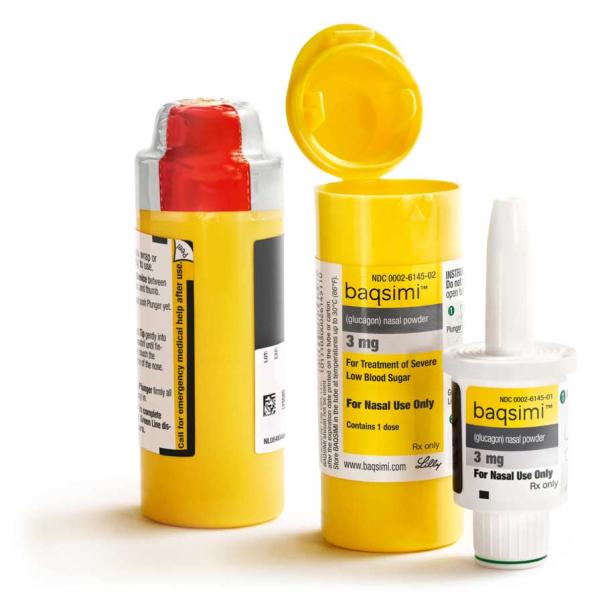Glucagon Dosage
Medically reviewed by Drugs.com. Last updated on Jan 31, 2025.
Applies to the following strengths: 1 mg; 3 mg; recombinant 1 mg; 0.5 mg/0.1 mL; 1 mg/0.2 mL
Usual Adult Dose for:
Usual Pediatric Dose for:
Additional dosage information:
Usual Adult Dose for Diagnostic
For relaxation of the stomach, duodenal bulb, duodenum, and small bowel:
IV: 0.2 mg to 0.5 mg IV prior to procedure
IM: 1 mg IM prior to procedure
For relaxation of the colon:
IV: 0.5 mg to 0.75 mg IV prior to procedure
IM: 1 mg to 2 mg IM prior to procedure
Comments:
- May be given IV or IM; onset of action will depend on the route of administration and the organ under examination.
- This drug is not recommended in combination with anticholinergic agents due to the possibility of increased side effects.
- After completion of the diagnostic procedure, oral carbohydrates should be given to patients who have been fasting as long as it is compatible with the procedure performed.
Use: As diagnostic aid during radiologic examinations to temporarily inhibit movement of the gastrointestinal tract.
Usual Adult Dose for Hypoglycemia
Glucagon Emergency Kit and GlucaGen HypoKit: 1 mg IM/IV or subcutaneously once
GVOKE Auto-Injector and Prefilled Syringes: 1 mg subcutaneously once
REPEAT DOSE: An unconscious patient will usually awaken within 15 minutes following treatment; if response is delayed, may repeat dose while waiting for emergency assistance
Nasal:
1 actuation (3 mg) into 1 nostril once
- If there is no response after 15 minutes, may administer an additional 3 mg dose from a new device while waiting for emergency assistance
Comments:
- Administer IV only under medical supervision.
- Patients should receive supplemental carbohydrates as soon as possible to restore liver glycogen and prevent recurrence of hypoglycemia.
- Patients who do not respond should receive IV glucose.
Use: For the treatment of severe hypoglycemia.
Usual Pediatric Dose for Hypoglycemia
Glucagon Emergency Kit and GlucaGen HypoKit:
WEIGHT-BASED DOSING:
Glucagon: Less than 20 kg: 0.5 mg (or 20 to 30 mcg/kg) IM/IV or subcutaneously once
Glucagon: 20 kg or greater: 1 mg IM/IV or subcutaneously once
GlucaGen: Less than 25 kg: 0.5 mg IM/IV or subcutaneously once
GlucaGen: 25 kg or greater: 1 mg IM/IV or subcutaneously once
AGE-BASED DOSING (when weight is unknown):
Less than 6 years: 0.5 mg IM/IV or subcutaneously once
6 years or older: 1 mg IM/IV or subcutaneously once
GVOKE Auto-Injector and Prefilled Syringes:
2 to 12 years (weight less than 45 kg): 0.5 mg subcutaneously once
2 to 12 years (weight 45 kg or greater): 1 mg subcutaneously once
12 years or older: 1 mg subcutaneously once
REPEAT DOSE: An unconscious patient will usually awaken within 15 minutes following treatment; if response is delayed, may repeat dose while waiting for emergency assistance
NASAL:
4 years or older: 1 actuation (3 mg) into 1 nostril once
- If there is no response after 15 minutes, an additional 3 mg dose from a new device may be administered while waiting for emergency assistance
Comments:
- Administer IV only under medical supervision.
- After patient has responded to treatment, supplemental carbohydrates should be given to restore liver glycogen and prevent recurrence of hypoglycemia.
- Patients who do not respond should receive IV glucose.
Uses: For the treatment of severe hypoglycemia.
- Gvoke auto-injector and prefilled syringes for subcutaneous use are indicated in patients 2 years or older; Baqisimi nasal powder is indicated in patients 4 years or older.
Renal Dose Adjustments
No adjustment recommended
Liver Dose Adjustments
No adjustment recommended
Dose Adjustments
Elderly Patients: Diagnostic use: Dosing should be conservative, usually starting at the low end of the dosing range.
Precautions
CONTRAINDICATIONS:
- Hypersensitivity to active substance or any product excipients; anaphylactic shock with breathing difficulties and hypotension have been reported
- Pheochromocytoma because of risk of substantial increase in blood pressure
- Insulinoma because of risk of hypoglycemia
- Glucagonoma (when used as a diagnostic aid) due to risk of hypoglycemia
Safety and efficacy for use as a diagnostic aid have not been established in patients younger than 18 years.
Safety and efficacy of nasal administration have not been established in patients younger than 4 years.
Safety and efficacy of Gvoke autoinjector and prefilled syringes have not been established in patients younger than 2 years.
Consult WARNINGS section for additional precautions.
Dialysis
Data not available
Other Comments
Administration advice:
Nasal Use:
- Do not push the plunger or test device prior to administration; each tube contains 1 device/1 dose; store in shrink wrapped tube until ready to use
- Administer 1 actuation into 1 nostril by inserting tip of intranasal device into 1 nostril and pressing device plunger all the way until the green line is no longer showing; the dose does not need to be inhaled
- If there is no response after 15 minutes, administer a second dose from a new device
Parenteral Use:
Glucagon Emergency Kit and GlucaGen HypoKit:
- Completely dissolve powder with diluent provided in the kit; shake vial gently until dissolved; use immediately after reconstitution; discard any unused portion; if a second injection is needed, use a new kit
- Administer IV, IM or subcutaneously; common injection sites include upper arms, thighs, or buttocks
GVOKE Auto-Injector and Prefilled Syringes:
- Do not open foil pouch until ready to administer
- Administer subcutaneously in lower abdomen, outer thigh, or outer upper arm
- Do not attempt to reuse; each device contains a single dose and cannot be reused
Treatment of Severe Hypoglycemia:
- Caregivers, family members, and school personnel may safely administer this drug after receiving proper instruction; emergency assistance should be sought immediately after administration
- An unconscious patient will usually awaken within 15 minutes following treatment; if there is no response after 15 minutes, a second dose should be given while waiting for emergency assistance
As a Diagnostic Aid: Restricted to use by medical personnel
- The GlucaGen diagnostic kits and GlucaGen 10-packs are not intended to treat severe hypoglycemia because they are not packaged with a syringe and diluent necessary for rapid preparation and administration during an emergency
- Completely dissolve powder with diluent provided or with 1 mL of sterile water for reconstitution; shake vial gently until dissolved
Storage requirements:
- Store at room temperature in original package; protect from light; do not freeze
- Glucagon Emergency Kit and GlucaGen HypoKit: Use immediately after reconstitution; discard any unused portion
- Gvoke Autoinjector and Prefilled Syringes: Store in original sealed foil pouch until time of use
- Nasal: Store in shrink wrapped tube until ready to use; if tube has been opened, moisture may cause the product to be ineffective; discard tube after use
General:
- An unconscious person experiencing severe hypoglycemia will usually awaken within 15 minutes following glucagon administration; if response is delayed, a second dose may be administered; emergency aid should be sought so that IV glucose may be given if needed.
- Once patient has responded to treatment for severe hypoglycemia, supplemental carbohydrates should be taken as soon as possible to restore liver glycogen and prevent recurrence of hypoglycemia.
- When used as a diagnostic aid, oral carbohydrates should be given to patients who have been fasting as long as it is compatible with the procedure performed.
Monitoring:
- Severe hypoglycemia; Blood glucose should be obtained until patient is asymptomatic
Patient advice:
- Patients should be instructed to read the FDA-approved patient labeling (Patient Information and Instructions for Use)
- Patients, family members, and caregivers should understand that severe hypoglycemia is a medical emergency and emergency medical assistance should be sought immediately after administering glucagon.
- Patients, family members, and caregivers should be familiar with preparation and product use prior to the emergence of severe hypoglycemia; his/her physician should be informed each time a severe hypoglycemic reaction occurs.
- Patients should understand that hypoglycemia affects a person's ability to concentrate and therefore tasks that require these abilities such as driving should be avoided until the risk of hypoglycemia is minimized.
Frequently asked questions
- When should you use glucagon?
- How long does Baqsimi last?
- Are glucagon and glycogen the same thing?
- Insulin vs Glucagon - What do they have in common?
- How does the release of glucagon affect blood glucose levels?
- How much does Baqsimi cost?
- Is Baqsimi covered by Medicare?
- How do you use Baqsimi nasal powder?
- How do you administer a glucagon injection kit?
More about glucagon
- Check interactions
- Compare alternatives
- Pricing & coupons
- Reviews (2)
- Latest FDA alerts (1)
- Side effects
- Patient tips
- During pregnancy
- Support group
- Drug class: glucose elevating agents
- Breastfeeding
Patient resources
- Glucagon drug information
- Glucagon nasal
- Glucagon (Injection) (Advanced Reading)
- Glucagon (Nasal) (Advanced Reading)
Other brands
Professional resources
Other brands
Related treatment guides
See also:
Further information
Always consult your healthcare provider to ensure the information displayed on this page applies to your personal circumstances.


